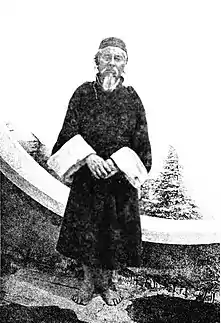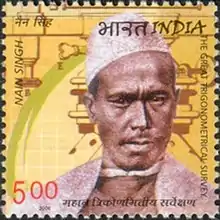Pundit (explorer)
The term pundit or pandit was used in the second half of the 19th century to denote indigenous surveyors who explored regions to the north of British India for the British.

Some of the notable native surveyors include the cousins Nain Singh Rawat and Krishna Singh Rawat.[1][2][3]
Great Trigonometric Survey of India
One of the greatest projects of 19th century geography was the Great Trigonometric Survey of India. The British also wanted geographical information on the lands further north. This was not just out of scientific curiosity: The Russians were attempting to expand their empire into Central Asia, and the British feared that they might have set their eyes on gaining the riches of India, which was at that time a British colony. Thus, the Russians and the British both tried to extend their influence in Asia. Knowledge of geography of the region was of course of utmost importance in this so-called 'Great Game'.
However, in some regions these surveys seemed impossible. Some of the Indian border countries, in particular Tibet, would not allow westerners to enter their country, let alone a British surveying team. In the 1860s, Thomas G. Montgomerie, a captain in the survey, realised that the solution to this problem would be to train natives from Indian border states such as Sikkim to be surveyors, and have them explore the region. These would raise less suspicion than Europeans, and might be able to make observations disguised as a trader or a lama (holy man). These native surveyors are called pundits. One such pundit, Kinthup was the first person to discover that the Tsangpo River was a tributary of the Brahmaputra – until that time it was not known whether it flowed to the Pacific or Indian Oceans.[4]
Methods

A number of tricks were developed to enable the pundits to make their observations without being found out. They were "trained to walk at precisely two thousand paces to the mile."[5] To count them, they used what looked like a Buddhist rosary, called a mala, but instead of the usual 108 beads it had 100,[5] every tenth being slightly larger. Every 100 paces a bead was dropped.[5] A prayer wheel did not hold the common Buddhist mantra Om mani padme hum, instead, "the scroll hidden within (...) was replaced by a blank rool of paper upon which data could be surreptitiously recorded."[5] Pundit Nain Singh Rawat also found that these could be used to ward off curious co-travelers: Each time someone came too near, he would start whirling the wheel around and thus pretend to be in religious contemplation. Usually this would be enough to stop others from addressing him. Another way of keeping their observations was to turn them into a poem, and recite that during their travels.
The pundits were given extensive training in surveying: They learned to use the sextant, determine height by measuring the temperature of boiling water, and make astronomical observations. They also received medical training. Despite the precautions and tricks, some of them were sent back, tortured or even executed. But with their travels they managed to map the Himalaya, Tibet and surrounding areas with remarkable precision.
Notable pundits
In literature
The training of a pundit is described in Rudyard Kipling's novel Kim.
See also
References
- Peter Hopkirk, 1982, "Trespassers on the Roof of the World: The Race for Lhasa", Oxford University Press.
- Derek J. Waller, 2004, "The Pundits: British Exploration of Tibet and Central Asia," University Press of Kentucky.
- Account of the Pundit's Journey in Great Tibet - Capt. H. Trotter, The Journal of the Royal Geographic Society (1877).
- Burrard, S. G. (1915). "The Identity of the Sanpo and Dihang Rivers". Bulletin of the American Geographical Society. American Geographical Society. 47 (4): 249–264. doi:10.2307/201464. JSTOR 201464.
- Davis, Wade (2012). Into the Silence : The Great War, Mallory, and the Conquest of Everest. New York: Vintage Books. pp. 49. ISBN 9780375708152. OCLC 773021726.
